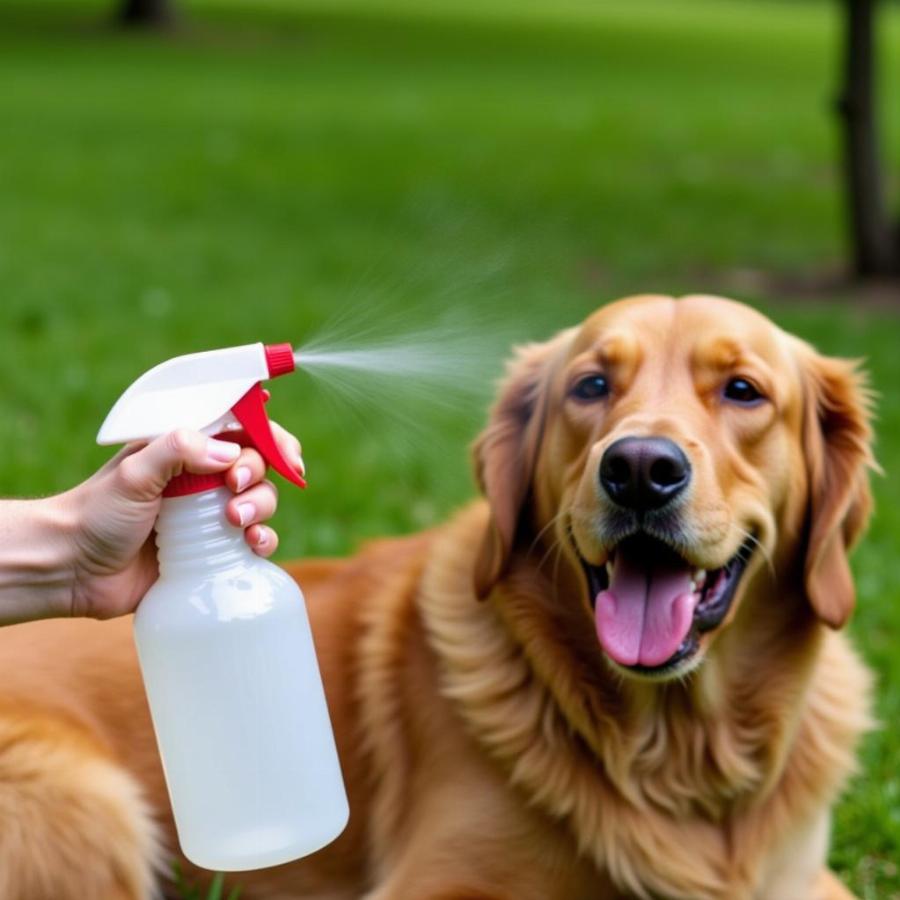Deer flies are a nuisance for everyone, but they can be especially bothersome for our canine companions. These pesky insects, with their painful bites and potential to transmit diseases, can make summertime outings less enjoyable. Fortunately, there are ways to protect your furry friend from these buzzing pests using simple, homemade solutions. Let’s explore how you can create effective deer fly protection for your dog right in your own kitchen.
Understanding the Deer Fly Threat
Before we delve into homemade remedies, it’s important to understand why deer flies are such a concern. These flies are attracted to movement, dark colors, and carbon dioxide, which dogs produce in abundance. Their bites aren’t just annoying; they can be quite painful and can even cause allergic reactions in some dogs. Plus, deer flies can carry diseases that can be transmitted to both pets and humans. So, protecting your dog from these pests isn’t just about comfort; it’s about their health, too.
Natural Repellents You Can Make at Home
Several natural ingredients have repellent properties that can deter deer flies. These options are often safer for your dog than commercial chemical repellents, especially if your dog has sensitive skin or allergies.
Essential Oil Blends
Essential oils, diluted properly, can be an effective way to keep deer flies at bay. Popular choices include citronella, lavender, eucalyptus, and lemongrass. However, it’s crucial to remember that essential oils must be diluted appropriately before use on dogs. A common dilution ratio is 1-3% essential oil to carrier oil like coconut or almond oil. Never apply undiluted essential oils directly to your dog’s skin.
Apple Cider Vinegar Spray
Apple cider vinegar (ACV) is another kitchen staple that can help repel deer flies. Mix equal parts ACV and water in a spray bottle. Spray lightly onto your dog’s fur, avoiding the eyes and face. The scent of ACV can discourage deer flies from landing on your dog.
Herbal Infusions
Certain herbs, like mint, rosemary, and basil, can also be used to create a deer fly repellent. Steep the herbs in hot water, allow to cool, and then strain the liquid. Pour the infusion into a spray bottle and apply it to your dog’s coat.
 Homemade Deer Fly Repellent Spray Being Applied to a Dog
Homemade Deer Fly Repellent Spray Being Applied to a Dog
Other Protective Measures
While homemade repellents can be effective, combining them with other protective measures can provide even better protection.
Physical Barriers
Consider using physical barriers to prevent deer flies from reaching your dog. Lightweight mesh clothing designed for dogs can be especially helpful during peak deer fly season. For smaller dogs, you might even consider a pet stroller with netting.
Strategic Timing
Deer flies are most active during certain times of the day, typically during daylight hours, especially on warm, sunny days. Try to avoid walking your dog during these peak periods. Early morning or evening walks are often a safer bet.
Choose Your Walking Locations Wisely
Deer flies are often found near wooded areas and standing water. If possible, choose walking routes that avoid these environments. Opt for open, breezy areas where deer flies are less prevalent.
What if My Dog Gets Bitten?
Despite your best efforts, your dog may still get bitten by a deer fly. Watch for signs of irritation, swelling, or infection. If you notice any of these, consult your veterinarian. They can recommend appropriate treatment, which might include antihistamines or topical creams.
Is DEET Safe for Dogs?
Never use DEET on dogs. DEET is a powerful chemical insecticide that can be toxic to dogs if ingested or absorbed through the skin. Stick to natural, dog-safe repellents to protect your furry friend.
“Always prioritize your dog’s safety when choosing insect repellents,” says Dr. Emily Carter, DVM. “Natural solutions are a great starting point, but if you have concerns about your dog’s specific needs, it’s always best to consult with your veterinarian.”
Conclusion
Protecting your dog from deer flies doesn’t have to be complicated. With a few simple homemade remedies and some strategic planning, you can keep your canine companion safe and comfortable during the summer months. Remember to always prioritize natural, dog-safe solutions, and consult your veterinarian if you have any concerns.
FAQ
- What are the signs of a deer fly bite on a dog? Look for redness, swelling, and possible itching or licking at the bite area.
- Can I use human insect repellent on my dog? No, many human insect repellents contain ingredients that are toxic to dogs.
- What is the best time of day to walk my dog to avoid deer flies? Early morning or evening are typically less active periods for deer flies.
- Are there any breeds of dogs that are more susceptible to deer fly bites? Dogs with thin coats or light-colored fur may be more attractive to deer flies.
- What should I do if my dog has an allergic reaction to a deer fly bite? Contact your veterinarian immediately.
- Can deer flies transmit diseases to dogs? Yes, deer flies can carry diseases that can affect both dogs and humans.
- How often should I reapply homemade deer fly repellent? Reapply every few hours, especially if your dog is swimming or playing in water.
Related Articles on Beaut Dogs
Currently, there are no related articles on Beaut Dogs specifically addressing deer fly protection.
Beaut Dogs
Beaut Dogs is your trusted source for all things related to dog care, providing expert advice and valuable insights to help you navigate the joys and challenges of dog ownership. From breed-specific information to comprehensive health and training guides, we strive to empower you with the knowledge you need to give your beloved companion the best possible care. For personalized support and answers to your specific questions, contact us at [email protected] (Email address). We’re here to help you every step of the way!